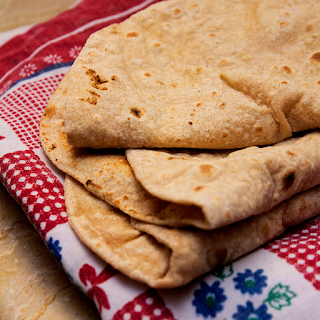TOP HEALTH BENEFITS OF CHAPATI
Ingredients:
Whole Wheat Flour (Atta): This is the main ingredient for chapati. It's preferable to use whole wheat flour for its nutritional value.
Water: The amount of water will depend on the quantity of flour and the desired consistency of the dough.
Salt: A pinch of salt is added to enhance the flavor of the chapati.
Preparation:
1. Making the Dough:
Measure Ingredients: Take the desired amount of whole wheat flour in a mixing bowl. A common ratio is approximately 2 cups of flour for 1 cup of water, but this can vary.
Add Salt: Sprinkle a pinch of salt into the flour. Salt is optional, but it adds flavor to the chapati.
Gradually Add Water: Add water little by little to the flour, mixing it simultaneously. Use your hands to form a dough.
Kneading: Once the dough starts to come together, transfer it to a clean, flat surface. Knead the dough for about 5-7 minutes until it becomes smooth and elastic.
This process helps activate the gluten in the flour, giving the chapati a softer texture.
Resting: Cover the dough with a damp cloth and let it rest for at least 15-20 minutes. This resting period allows the gluten to relax, making the dough easier to roll.
2. Dividing and Rolling:
Divide into Balls: After resting, divide the dough into small lemon-sized balls. This makes it easier to handle and roll.
Flour Dusting: Take a ball of dough, dip it in dry flour, and roll it between your palms to make a smooth ball. Dust it with a bit of dry flour to prevent sticking.
Rolling: Use a rolling pin to flatten each ball into a thin, circular shape. Rotate the chapati while rolling to maintain an even thickness.
3. Cooking:
Heating the Griddle (Tawa): Preheat a griddle or tawa on medium-high heat. It's essential to have a hot surface for the chapati to cook properly.
Placing the Chapati: Gently place the rolled chapati onto the hot griddle. When you see small bubbles forming on the surface, flip it using flat spatulas.
Puffing: If everything is done right, the chapati will puff up. You can press the edges gently with a spatula to help it puff up evenly.
Cooking Both Sides: Cook both sides until you see light brown spots, ensuring the chapati is cooked through.
4. Serving:
Keep Warm: Once cooked, you can keep the chapatis warm by stacking them and covering with a clean cloth or placing them in a covered container.
Serving with Accompaniments: Chapatis can be served with a variety of side dishes such as curries, dal, vegetables, or even with yogurt and pickles.
Tips:
Consistency of Dough: Achieving the right consistency of the dough is crucial. It should be soft and pliable but not sticky.
Rolling Thickness: Aim for a consistent thickness while rolling to ensure even cooking.
Cooking Temperature: A hot griddle is key to puffing the chapati. If the griddle is not hot enough, the chapati may not puff.
Practice: Chapati making is a skill that improves with practice. Don't be discouraged if your first few chapatis are not perfect.
Health Benefits:
Rich in Dietary Fiber:
Benefit: Whole wheat flour used in chapati is high in dietary fiber, promoting better digestion.
Effect: It helps prevent constipation and supports a healthy digestive system.
Low in Saturated Fat and Cholesterol:
Benefit: Chapati is naturally low in saturated fat and contains no cholesterol.
Effect: This makes it a heart-healthy choice, helping to manage cholesterol levels and reduce the risk of heart disease.
Balanced Energy Source:
Benefit: The complex carbohydrates in chapati provide a steady release of energy.
Effect: It helps maintain energy levels throughout the day and prevents sudden spikes and crashes in blood sugar.
Source of Essential Nutrients:
Benefit: Whole wheat flour is a good source of essential nutrients like vitamins (B-complex vitamins) and minerals (iron, magnesium).
Effect: These nutrients are crucial for various bodily functions, including energy metabolism and maintaining healthy blood.
Weight Management:
Benefit: Chapati is a filling food due to its fiber content.
Effect: It can contribute to a feeling of fullness, aiding in weight management by reducing overall calorie intake.
Suitable for Various Diets:
Benefit: Chapati is a versatile food that can be incorporated into various diets.
Effect: It is commonly included in vegetarian, vegan, and plant-based diets as a primary source of carbohydrates.
Nutritional Benefits:
Whole Wheat Flour:
Benefit: Chapati is typically made with whole wheat flour, which retains the bran and germ layers of the wheat kernel.
Effect: This provides more nutrients, including fiber, B-vitamins, and minerals compared to refined flour.
Protein Content:
Benefit: Whole wheat flour contains a moderate amount of protein.
Effect: Protein is essential for the repair and growth of body tissues and can contribute to a feeling of satiety.
Iron Content:
Benefit: Whole wheat flour is a source of iron.
Effect: Iron is important for the formation of hemoglobin, which carries oxygen in the blood.
B-Vitamins:
Benefit: Chapati provides B-complex vitamins such as niacin, thiamine, and riboflavin.
Effect: These vitamins play a role in energy metabolism, supporting the conversion of food into energy.
Minerals:
Benefit: Chapati contains minerals like magnesium and phosphorus.
Effect: These minerals are important for bone health, nerve function, and energy metabolism.
It's important to note that while chapati itself is a healthy option, the overall health impact of a meal depends on the accompanying dishes and ingredients.
Combining chapati with a variety of nutrient-rich vegetables, legumes, and lean proteins enhances its nutritional profile and contributes to a balanced and wholesome diet.
.png)
.png)

.png)


Comments
Post a Comment